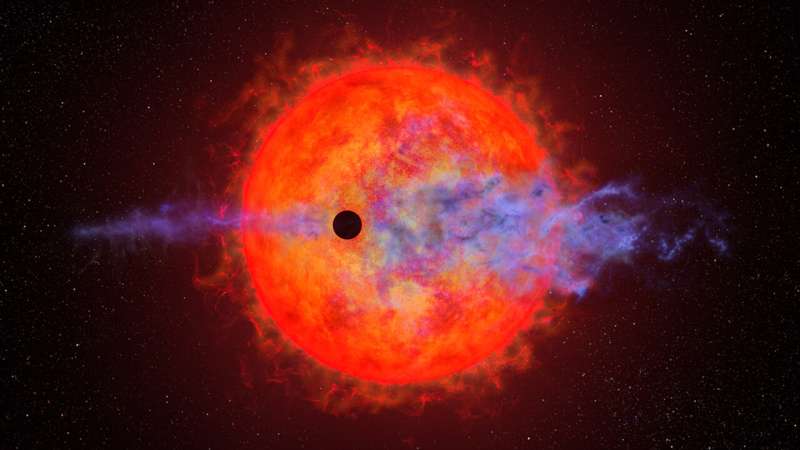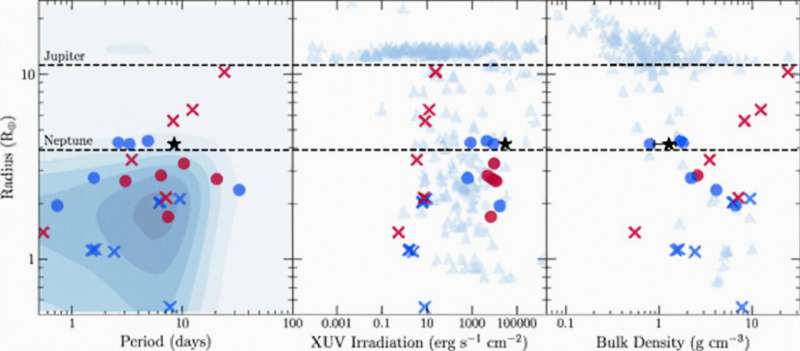This article has been reviewed according to Science X's editorial process and policies. Editors have highlighted the following attributes while ensuring the content's credibility:
fact-checked
peer-reviewed publication
trusted source
proofread
Hubble sees evaporating planet getting the hiccups

Life around an ill-tempered red dwarf star is no fun for accompanying newborn planets. Call it a baptism of fire. Entangled magnetic fields cause a red dwarf to spit out "super-flares" that are 100 to 1,000 times more powerful than similar flares seen on our sun. That is coupled with blistering ultraviolet radiation requiring any of the star system's inhabitants to use "sunscreen 5,000."
One of the nearest and most violent examples is AU Microscopii. The petulant star is only 1% the age of our sun. At a distance of 32 light-years, it is only eight times farther away than the nearest star to our sun, Proxima Centauri (which is another red dwarf).
The star beats-up the system's innermost planet, AU Microscopii b, which is about four times Earth's diameter. Orbiting just 6 million miles from the evil star's "dragon's breath," the planet's largely hydrogen atmosphere is being stripped off, as viewed by the Hubble Space Telescope. But this happens in fits and starts.
During one passage of the planet across the face if its star, Hubble detected hydrogen boiling off to create a large cloud ahead of the planet. This unexpected variability is evidence that the interaction between the planet and the red dwarf's feisty fireworks is probably more complex and unpredictable than imagined.
A young planet whirling around a petulant red dwarf star is changing in unpredictable ways orbit-by-orbit. It is so close to its parent star that it experiences a consistent, torrential blast of energy, which evaporates its hydrogen atmosphere—causing it to puff off the planet.
But during one orbit observed with the Hubble Space Telescope, the planet looked like it wasn't losing any material at all, while an orbit observed with Hubble a year and a half later showed clear signs of atmospheric loss.
This extreme variability between orbits shocked astronomers. "We've never seen atmospheric escape go from completely not detectable to very detectable over such a short period when a planet passes in front of its star," said Keighley Rockcliffe of Dartmouth College in Hanover, New Hampshire. "We were really expecting something very predictable, repeatable. But it turned out to be weird. When I first saw this, I thought 'That can't be right.'"
Rockcliffe was equally puzzled to see, when it was detectable, the planet's atmosphere puffing out in front of the planet, like a headlight on a fast-bound train. "This frankly strange observation is kind of a stress-test case for the modeling and the physics about planetary evolution. This observation is so cool because we're getting to probe this interplay between the star and the planet that is really at the most extreme," she said.
Located 32 light-years from Earth, the parent star AU Microscopii (AU Mic) hosts one of the youngest planetary systems ever observed. The star is less than 100 million years old (a tiny fraction of the age of our sun, which is 4.6 billion years old). The innermost planet, AU Mic b, has an orbital period of 8.46 days and is just 6 million miles from the star (about 1/10th the planet Mercury's distance from our sun). The bloated, gaseous world is about four times Earth's diameter.
AU Mic b was discovered by NASA's Spitzer and TESS (Transiting Exoplanet Survey Satellite) space telescopes in 2020. It was spotted with the transit method, meaning telescopes can observe a slight dip in the star's brightness when the planet crosses in front of it.

Red dwarfs like AU Microscopii are the most abundant stars in our Milky Way galaxy. They therefore should host the majority of planets in our galaxy. But can planets orbiting red dwarf stars like AU Mic b be hospitable to life? A key challenge is that young red dwarfs have ferocious stellar flares blasting out withering radiation. This period of high activity lasts a lot longer than that of stars like our sun.
The flares are powered by intense magnetic fields that get tangled by the roiling motions of the stellar atmosphere. When the tangling gets too intense, the fields break and reconnect, unleashing tremendous amounts of energy that are 100 to 1,000 times more energetic than our sun unleashes in its outbursts.
It's a blistering fireworks show of torrential winds, flares, and X-rays blasting any planets orbiting close to the star. "This creates a really unconstrained and frankly, scary, stellar wind environment that's impacting the planet's atmosphere," said Rockcliffe.
Under these torrid conditions, planets forming within the first 100 million years of the star's birth should experience the most amount of atmospheric escape. This might end up completely stripping a planet of its atmosphere.
"We want to find out what kinds of planets can survive these environments. What will they finally look like when the star settles down? And would there be any chance of habitability eventually, or will they wind up just being scorched planets?" said Rockcliffe. "Do they eventually lose most of their atmospheres and their surviving cores become super-Earths? We don't really know what those final compositions look like because we don't have anything like that in our solar system."
While the star's glare prevents Hubble from directly seeing the planet, the telescope can measure changes in the star's apparent brightness caused by hydrogen bleeding off the planet and dimming the starlight when the planet transits the star. That atmospheric hydrogen has been heated to the point where it escapes the planet's gravity.
The never-before-seen changes in atmospheric outflow from AU Mic b may indicate swift and extreme variability in the host red dwarf's outbursts. There is so much variability because the star has a lot of roiling magnetic field lines. One possible explanation for the missing hydrogen during one of the planet's transits is that a powerful stellar flare, seen seven hours prior, may have photoionized the escaping hydrogen to the point where it became transparent to light, and so was not detectable.
Another explanation is that the stellar wind itself is shaping the planetary outflow, making it observable at some times and not observable at other times, even causing some of the outflow to "hiccup" ahead of the planet itself. This is predicted in some models, like those of John McCann and Ruth Murray-Clay from the University of California at Santa Cruz, but this is the first kind of observational evidence of it happening and to such an extreme degree, say researchers.
Hubble follow-up observations of more AU Mic b transits should offer additional clues to the star and planet's odd variability, further testing scientific models of exoplanetary atmospheric escape and evolution.
Rockcliffe is lead author on the science paper published in The Astronomical Journal.
More information: Keighley E. Rockcliffe et al, The Variable Detection of Atmospheric Escape around the Young, Hot Neptune AU Mic b, The Astronomical Journal (2023). DOI: 10.3847/1538-3881/ace536
Journal information: Astronomical Journal
Provided by ESA/Hubble Information Centre





















